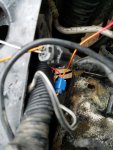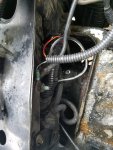Craig0320
Well-Known Member
Supporting Member
Article Contributor
V8 Engine Swap
TRS 20th Anniversary
- Joined
- Sep 21, 2017
- Messages
- 1,209
- City
- Mississppi
- Vehicle Year
- 1998
- Engine
- Transmission
- Automatic
- My credo
- Break it right the first time. Fix it better the next time.
I didn't use the relay and just hooked the wires up direct. Both the 4hi and 4low lights came on when in 4lo. didn't bother me and I liked it that way.
Transfer Case Indicator Lights Hookup
Using the Ford CD and a pigtail, I wired up the dash lights for my transfer case. It was easy.
Besides the case, obviously, you need:
• approx 10 feet of small gauge wire
• wire connectors
• relay (optional)
• wiring diagram of your vehicle
This is an easy job to do and in my opinion worth the effort.
1. Remove the radio bezel, there are two screws under the radio to remove it, they are 7mm. Unhook all of the connectors that are hooked to the bezel.
2. Remove the radio if necessary. I have an aftermarket radio and it came out with the bezel.
3. On the left side of the hole in the dash, the GEM is mounted vertically.
4. Using your wiring diagram, locate the two wires that go to the dash indicators. I would think many years would be similar, but Ford likes to change things up, so do your research. My wires were grey and light blue w/ black stripe.

5. Now that you have the wires located run the wires from the dash to the bottom side of the body. I ran my wires under the carpet to a plug in the body about the size of a quarter that came out just on the outside of the frame on the drivers side.
6. Wire the wires to the two coming from the pigtail. It doesn't matter at this point which wire is which, so just hook them up.



7. Find your shift indicator switch on the transfer case. It is near the shift fork and takes a 22mm hand wrench to remove.
8. Route the wire away from the driveshaft and plug it into the switch. I ran mine from the plug over the frame, over the shift linkage bar, behind the vent hose to ensure id doesn't get near the driveshaft.
9. Go back to the cab. The two wires that you found earlier you need to strip some insulation away from. I just took a wire stripper and cut and pushed the insulation.
10. At this point, don't connect the wires permanantly. Pull your case into 4 hi. Taking one wire from the case at a time touch it to the wire that runs to the dash. Find the wire that lights up the 4 high light.


At this point, you need to decide if it will bother you to have both the high and low light on when the case in in low. The switch works by putting a ground signal when the case is in 4 high, when you pull it into 4 low, the 4 high light and the 4 low light will illuminate if you just hook up the wires. It works well enough I guess, but I wanted it to be correct. Using a standard relay, you can do some simple wiring to correct this.
If It doesn't bother you, hook the wires up and you are done.

EDIT: This sounds confusing, but I don't really know how to make it clearer. (I'm open to suggestions) Once you get in there, it should make more sense.
11. To wire the relay, find a 12v positive source. The wire for the cigar lighter comes from the GEM and will work for this. Wire the relay as follows-
12v + to the 85 post
Connect the wire from the transfer case that comes on when in 4 low to the 86 post
Connect the wire from the transfer case that comes on when in 4 high to the 30 post
Connect a wire from the 87a post to the wire that goes to the 4 high light
12. Connect the wire from the case that comes on when in 4 low to the wire that goes to the 4 low dash light.
The way this works is, the ground from the 4 low signal trips the relay, cutting the signal to the 4 high light. The 4 high light now only works when in 4 high.
Thats it, put the radio and bezel back and your done!
Transfer Case Indicator Lights Hookup
Using the Ford CD and a pigtail, I wired up the dash lights for my transfer case. It was easy.
Besides the case, obviously, you need:
• approx 10 feet of small gauge wire
• wire connectors
• relay (optional)
• wiring diagram of your vehicle
This is an easy job to do and in my opinion worth the effort.
1. Remove the radio bezel, there are two screws under the radio to remove it, they are 7mm. Unhook all of the connectors that are hooked to the bezel.
2. Remove the radio if necessary. I have an aftermarket radio and it came out with the bezel.
3. On the left side of the hole in the dash, the GEM is mounted vertically.
4. Using your wiring diagram, locate the two wires that go to the dash indicators. I would think many years would be similar, but Ford likes to change things up, so do your research. My wires were grey and light blue w/ black stripe.
5. Now that you have the wires located run the wires from the dash to the bottom side of the body. I ran my wires under the carpet to a plug in the body about the size of a quarter that came out just on the outside of the frame on the drivers side.
6. Wire the wires to the two coming from the pigtail. It doesn't matter at this point which wire is which, so just hook them up.
7. Find your shift indicator switch on the transfer case. It is near the shift fork and takes a 22mm hand wrench to remove.
8. Route the wire away from the driveshaft and plug it into the switch. I ran mine from the plug over the frame, over the shift linkage bar, behind the vent hose to ensure id doesn't get near the driveshaft.
9. Go back to the cab. The two wires that you found earlier you need to strip some insulation away from. I just took a wire stripper and cut and pushed the insulation.
10. At this point, don't connect the wires permanantly. Pull your case into 4 hi. Taking one wire from the case at a time touch it to the wire that runs to the dash. Find the wire that lights up the 4 high light.
At this point, you need to decide if it will bother you to have both the high and low light on when the case in in low. The switch works by putting a ground signal when the case is in 4 high, when you pull it into 4 low, the 4 high light and the 4 low light will illuminate if you just hook up the wires. It works well enough I guess, but I wanted it to be correct. Using a standard relay, you can do some simple wiring to correct this.
If It doesn't bother you, hook the wires up and you are done.
EDIT: This sounds confusing, but I don't really know how to make it clearer. (I'm open to suggestions) Once you get in there, it should make more sense.
11. To wire the relay, find a 12v positive source. The wire for the cigar lighter comes from the GEM and will work for this. Wire the relay as follows-
12v + to the 85 post
Connect the wire from the transfer case that comes on when in 4 low to the 86 post
Connect the wire from the transfer case that comes on when in 4 high to the 30 post
Connect a wire from the 87a post to the wire that goes to the 4 high light
12. Connect the wire from the case that comes on when in 4 low to the wire that goes to the 4 low dash light.
The way this works is, the ground from the 4 low signal trips the relay, cutting the signal to the 4 high light. The 4 high light now only works when in 4 high.
Thats it, put the radio and bezel back and your done!















